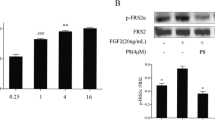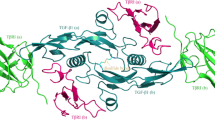Abstract
Matrix metalloproteinases (MMPs) play critical roles in the invasiveness of cancerous cells and metastasis of solid tumors. MMP-9 is a member of this protease family, which is extremely overexpressed in metastatic cells. Here, we described a cyclic peptide which inhibits the MMP-9 activity with high potency. This inhibitor selectively binds to the MMP-9 fibronectin domain and interferes with the interaction of gelatinous substrates with MMP-9, thereby suppressing its gelatinolytic activity. Previously, we isolated and developed a linear peptide, named as RSH-12, from a phage display library which displayed promising results in the inhibition of MMP-9. Next, we decided to improve its biostability via cyclization chemistry and show that RSH-12 has a considerably enhanced stability in human serum. Moreover, the cyclic peptide is still associated with a high potency to inhibit the invasion activity of a human fibrosarcoma cell line. These results demonstrate that the designed cyclic peptide might be considered as a promising therapeutic moiety to target the MMP-9 for the treatment of cancer.








Similar content being viewed by others
Data Availability
Data will be made available on request.
References
Amar S, Fields GB (2015) Potential clinical implications of recent matrix metalloproteinase inhibitor design strategies. Expert Rev Proteomics 12:445–447
Beaufays J, Lins L, Thomas A, Brasseur R (2012) In silico predictions of 3D structures of linear and cyclic peptides with natural and non-proteinogenic residues. J Pept Sci 18:17–24
Bickett DM, Green MD, Berman J et al (1993) A high throughput fluorogenic substrate for interstitial collagenase (MMP-1) and gelatinase (MMP-9). Anal Biochem 212:58–64
Bowden ET, Coopman PJ, Mueller SC (2001) Invadopodia: unique methods for measurement of extracellular matrix degradation in vitro. Methods Cell Biol 63:613–627
Bruno BJ, Miller GD, Lim CS (2013) Basics and recent advances in peptide and protein drug delivery. Ther Deliv 4:1443–1467
Caley MP, Martins VLC, O’Toole EA (2015) Metalloproteinases and wound healing. Adv Wound Care 4:225–234
Cardote TAF, Ciulli A (2016) Cyclic and macrocyclic peptides as chemical tools to recognise protein surfaces and probe protein–protein interactions. ChemMedChem 11:787–794
Collier IE, Krasnov PA, Strongin AY et al (1992) Alanine scanning mutagenesis and functional analysis of the fibronectin-like collagen-binding domain from human 92-kDa type IV collagenase. J Biol Chem 267:6776–6781
Deryugina EI, Quigley JP (2015) Tumor angiogenesis: MMP-mediated induction of intravasation-and metastasis-sustaining neovasculature. Matrix Biol 44:94–112
Engel CK, Pirard B, Schimanski S et al (2005) Structural basis for the highly selective inhibition of MMP-13. Chem Biol 12:181–189
Fields GB (2015) New strategies for targeting matrix metalloproteinases. Matrix Biol 44:239–246
Fields GB (2019) The rebirth of matrix metalloproteinase inhibitors: moving beyond the dogma. Cells 8:984
Fields GB (2019) Mechanisms of action of novel drugs targeting angiogenesis-promoting matrix metalloproteinases. Front Immunol 10:1278
Gang D, Kim DW, Park H-S (2018) Cyclic peptides: promising scaffolds for biopharmaceuticals. Genes (Basel) 9:557
Gege C, Bao B, Bluhm H et al (2012) Discovery and evaluation of a non-Zn chelating, selective matrix metalloproteinase 13 (MMP-13) inhibitor for potential intra-articular treatment of osteoarthritis. J Med Chem 55:709–716
Huang H, Rabenstein DL (1999) A cleavage cocktail for methionine-containing peptides. J Pept Res 53:548–553
Hurd CA, Mott HR, Owen D (2020) Therapeutic peptides targeting the Ras superfamily. Pept Sci 112:e24165
Kim YH, Kwon H-J, Kim D-S (2012) Matrix metalloproteinase 9 (MMP-9)-dependent processing of βig-h3 protein regulates cell migration, invasion, and adhesion. J Biol Chem 287:38957–38969
La Rocca G, Pucci-Minafra I, Marrazzo A et al (2004) Zymographic detection and clinical correlations of MMP-2 and MMP-9 in breast cancer sera. Br J Cancer 90:1414–1421
Li P, Roller PP (2002) Cyclization strategies in peptide derived drug design. Curr Top Med Chem 2:325–341
Maupetit J, Derreumaux P, Tufféry P (2010) A fast method for large-scale de novo peptide and miniprotein structure prediction. J Comput Chem 31:726–738
Mondal S, Adhikari N, Banerjee S et al (2020) Matrix metalloproteinase-9 (MMP-9) and its inhibitors in cancer: a minireview. Eur J Med Chem 194:112260
Ndinguri MW, Bhowmick M, Tokmina-Roszyk D et al (2012) Peptide-based selective inhibitors of matrix metalloproteinase-mediated activities. Molecules 17:14230–14248
Page-McCaw A, Ewald AJ, Werb Z (2007) Matrix metalloproteinases and the regulation of tissue remodelling. Nat Rev Mol Cell Biol 8:221–233
Pirard B (2007) Insight into the structural determinants for selective inhibition of matrix metalloproteinases. Drug Discov Today 12:640–646
Raeeszadeh-Sarmazdeh M, Do LD, Hritz BG (2020) Metalloproteinases and their inhibitors: potential for the development of new therapeutics. Cells 9:1313
Rafferty J, Nagaraj H, McCloskey P et al (2016) Peptide therapeutics and the pharmaceutical industry: barriers encountered translating from the laboratory to patients. Curr Med Chem 23:4231–4259
Remacle AG, Golubkov VS, Shiryaev SA et al (2012) Novel MT1-MMP small-molecule inhibitors based on insights into hemopexin domain function in tumor growth. Cancer Res 72:2339–2349
Rijkers DTS, den Hartog JAJ, Liskamp RMJ (2002) An optimized solid phase synthesis strategy—including on-resin lactamization—of astressin, its retro‐, inverso‐, and retro–inverso isomers as corticotropin releasing factor antagonists. Biopolymers 63:141–149
Roldán V, Marín F, Gimeno JR et al (2008) Matrix metalloproteinases and tissue remodeling in hypertrophic cardiomyopathy. Am Heart J 156:85–91
Scorilas A, Karameris A, Arnogiannaki N et al (2001) Overexpression of matrix-metalloproteinase-9 in human breast cancer: a potential favourable indicator in node-negative patients. Br J Cancer 84:1488–1496
Sela-Passwell N, Rosenblum G, Shoham T, Sagi I (2010) Structural and functional bases for allosteric control of MMP activities: can it pave the path for selective inhibition? Biochim Biophys Acta (BBA) 1803:29–38
Shipley JM, Doyle GAR, Fliszar CJ et al (1996) The structural basis for the elastolytic activity of the 92-kDa and 72-kDa gelatinases: role of the fibronectin type II-like repeats. J Biol Chem 271:4335–4341
Shoari A, Rasaee MJ, Kanavi MR, Daraei B (2019) Functional mimetic peptide discovery isolated by phage display interacts selectively to fibronectin domain and inhibits gelatinase. J Cell Biochem 120:19699–19711
Shoari A, Rasaee MJ, Rezaei Kanavi M et al (2021) In vivo effect of RSH-12, a novel selective mmp-9 inhibitor peptide, in the treatment of experimentally induced dry eye model. Curr Eye Res 46:7–13
Tala SR, Schnell SM, Haskell-Luevano C (2015) Microwave-assisted solid-phase synthesis of side-chain to side-chain lactam-bridge cyclic peptides. Bioorg Med Chem Lett 25:5708–5711
Thell K, Hellinger R, Schabbauer G, Gruber CW (2014) Immunosuppressive peptides and their therapeutic applications. Drug Discov Today 19:645–653
Ugarte-Berzal E, Vandooren J, Bailón E et al (2016) Inhibition of MMP-9-dependent degradation of gelatin, but not other MMP-9 substrates, by the MMP-9 hemopexin domain blades 1 and 4. J Biol Chem 291:11751–11760
Vandooren J, Van den Steen PE, Opdenakker G (2013) Biochemistry and molecular biology of gelatinase B or matrix metalloproteinase-9 (MMP-9): the next decade. Crit Rev Biochem Mol Biol 48:222–272
Wang X, Yu YY, Lieu S et al (2013) MMP9 regulates the cellular response to inflammation after skeletal injury. Bone 52:111–119
Wu C-H, Liu I-J, Lu R-M, Wu H-C (2016) Advancement and applications of peptide phage display technology in biomedical science. J Biomed Sci 23:1–14
Zani M-L, Moreau T (2010) Phage display as a powerful tool to engineer protease inhibitors. Biochimie 92:1689–1704
Zapico JM, Puckowska A, Filipiak K et al (2015) Design and synthesis of potent hydroxamate inhibitors with increased selectivity within the gelatinase family. Org Biomol Chem 13:142–156
Author information
Authors and Affiliations
Corresponding authors
Ethics declarations
Conflict of interest
No potential conflict of interest was reported by the author(s).
Additional information
Publisher’s Note
Springer Nature remains neutral with regard to jurisdictional claims in published maps and institutional affiliations.
Supplementary Information
Below is the link to the electronic supplementary material.
Rights and permissions
Springer Nature or its licensor holds exclusive rights to this article under a publishing agreement with the author(s) or other rightsholder(s); author self-archiving of the accepted manuscript version of this article is solely governed by the terms of such publishing agreement and applicable law.
About this article
Cite this article
Shoari, A., Khalili, S., Rasaee, M.J. et al. A Phage Display Derived Cyclized Peptide Inhibits Fibrosarcoma Cells Invasion via Suppression of MMP-9 Activity. Int J Pept Res Ther 28, 136 (2022). https://doi.org/10.1007/s10989-022-10446-6
Accepted:
Published:
DOI: https://doi.org/10.1007/s10989-022-10446-6




